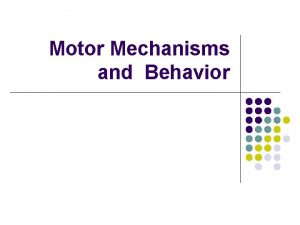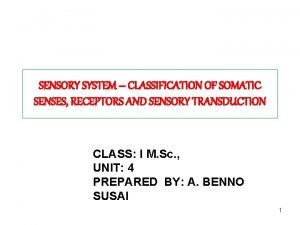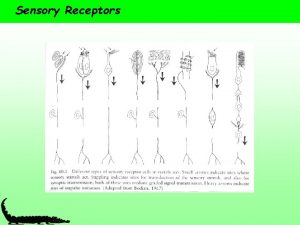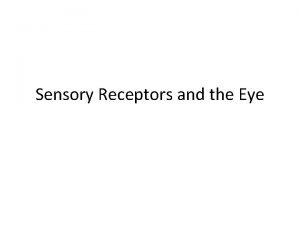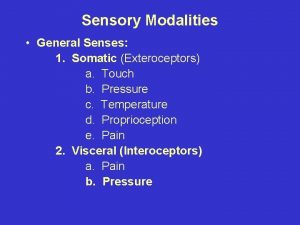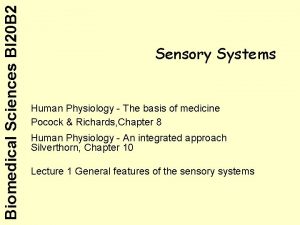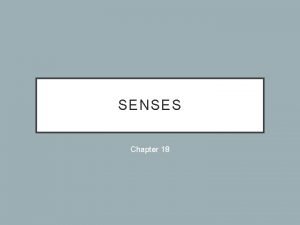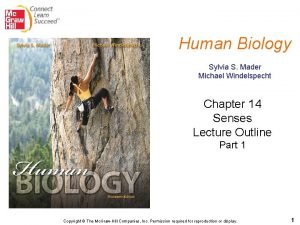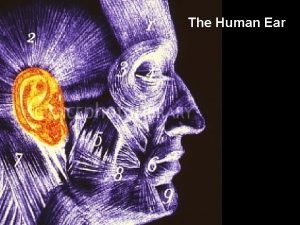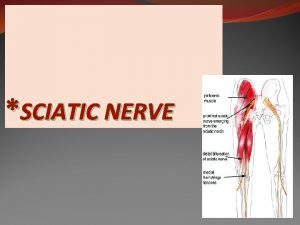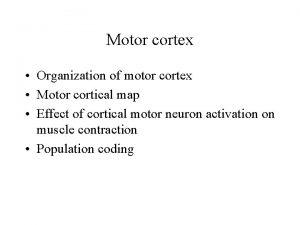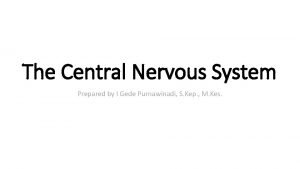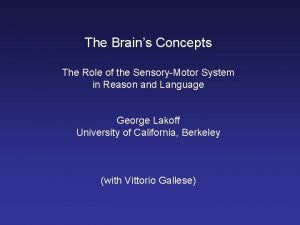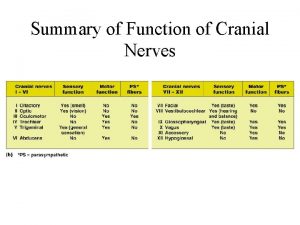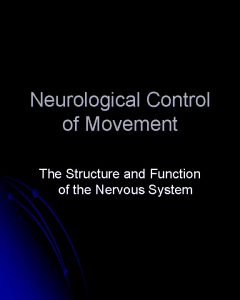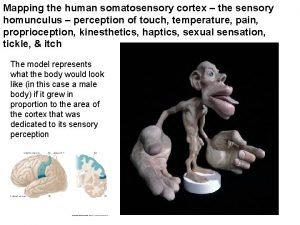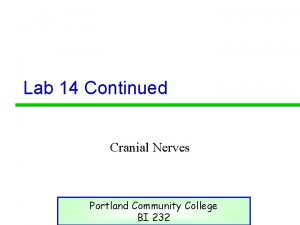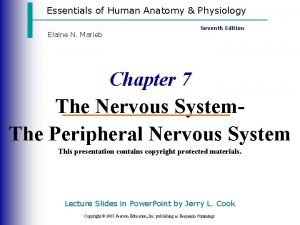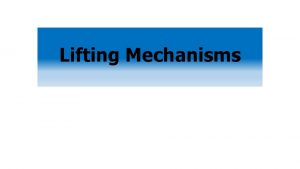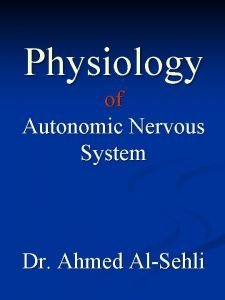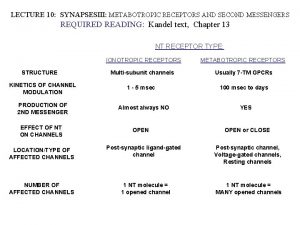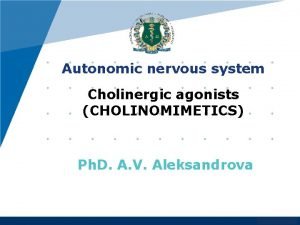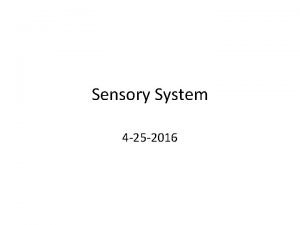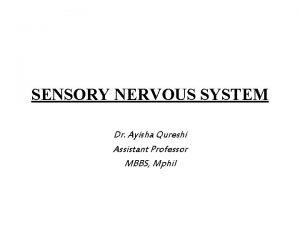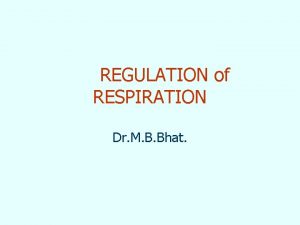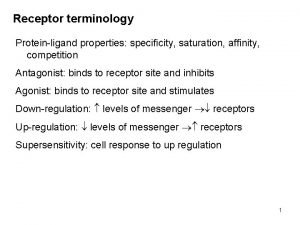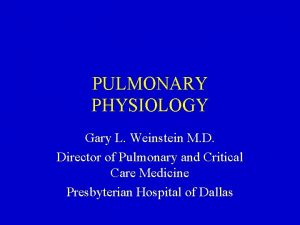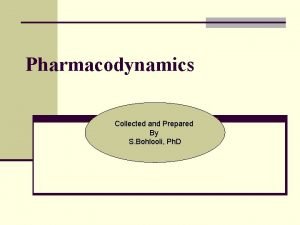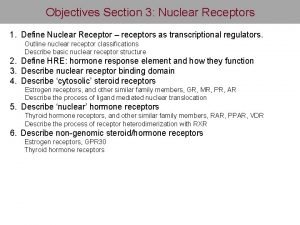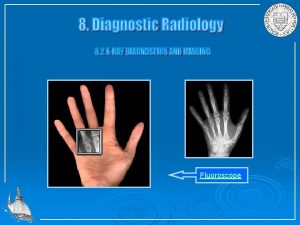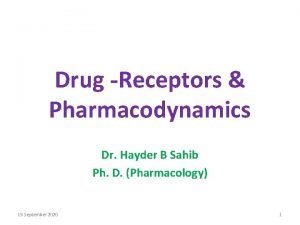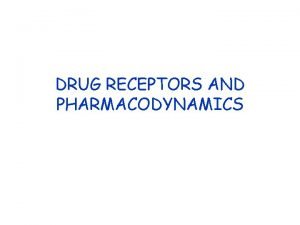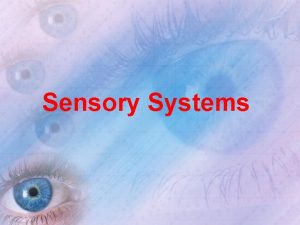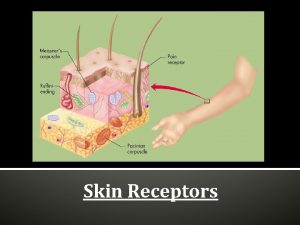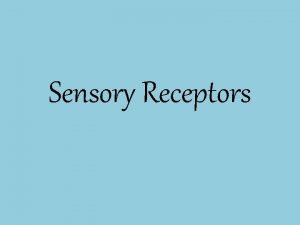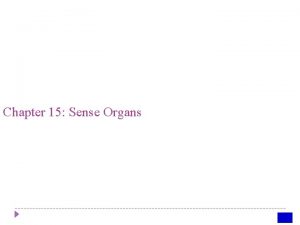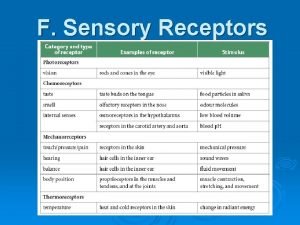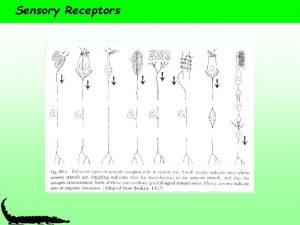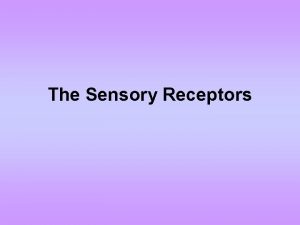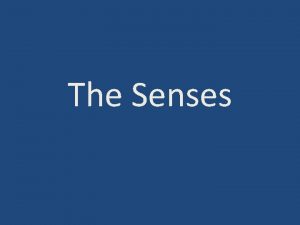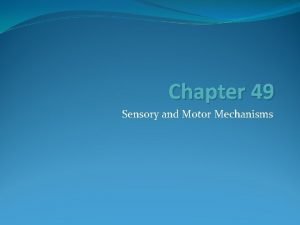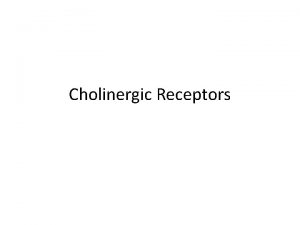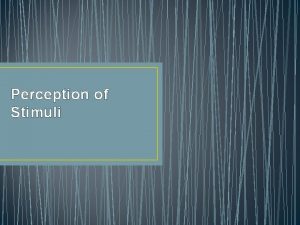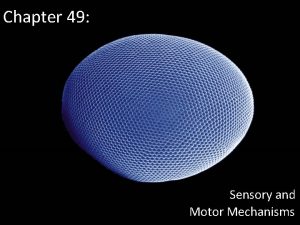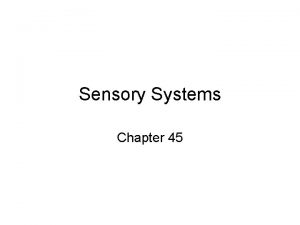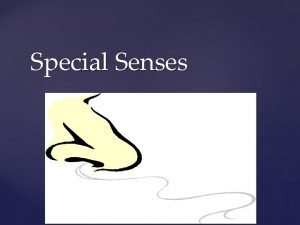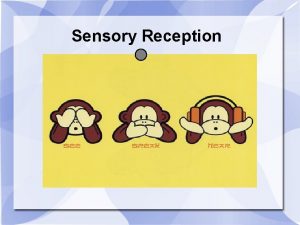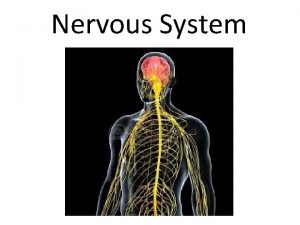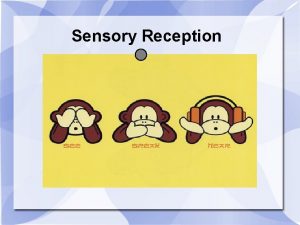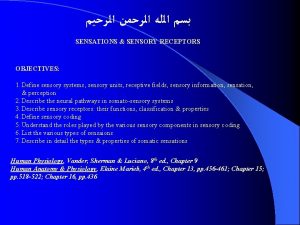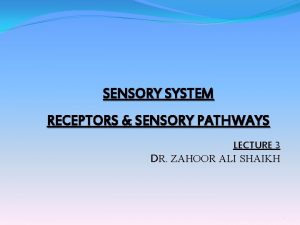Chapter 49 Sensory and Motor Mechanism Sensory receptors






















































- Slides: 54

Chapter 49: Sensory and Motor Mechanism

Sensory receptors transduce stimulus energy and transmit signals to the central nervous system n Sensations are action potentials n ¨ That n reach the brain via sensory neurons Once the brain is aware of sensations ¨ It interprets them, giving the perception of stimuli

n Sensations and perceptions ¨ Begin with sensory reception, the detection of stimuli by sensory receptors n Exteroreceptors ¨ Detect stimuli coming from the outside of the body n Interoreceptors ¨ Detect internal stimuli

Functions Performed by Sensory Receptors All stimuli represent forms of energy n Sensation involves converting this energy n ¨ Into a change in the membrane potential of sensory receptors n Sensory receptors perform four functions in this process ¨ Sensory transduction, amplification, transmission, and integration

n Two types of sensory receptors exhibit these functions ¨A stretch receptor in a crayfish Weak muscle stretch Muscle Stretch receptor Axon Membrane potential (m. V) Dendrites – 50 Receptor potential – 50 – 70 Action potentials 0 0 – 70 0 1 2 3 4 5 6 7 Time (sec) (a) Crayfish stretch receptors have dendrites embedded in abdominal muscles. When the abdomen bends, muscles and dendrites Figure 49. 2 a Strong muscle stretch, producing a receptor potential in the stretch receptor. The receptor potential triggers action potentials in the axon of the stretch 01 2 3 4 5 67 Time (sec) receptor. A stronger stretch produces a larger receptor potential and higher requency of action potentials.

Fluid moving in other direction hair cell found in vertebrates More neurotransmitter Less neurotransmitter – 50 Membrane potential (m. V) Axon – 70 Action potentials 0 – 70 0 (b) Vertebrate hair cells have specialized cilia or microvilli (“hairs”) that bend when surrounding fluid moves. Each hair cell releases an excitatory neurotransmitter at a synapse – 70 01 2 3 4 5 6 7 Time (sec) Figure 49. 2 b – 50 Receptor potential Membrane potential (m. V) ¨A Neurotransmitter at synapse Fluid moving in one direction No fluid movement Membrane potential (m. V) “Hairs” of hair cell 0 1 2 3 4 5 6 7 Time (sec) with a sensory neuron, which conducts action potentials to the CNS. Bending in one direction depolarizes the hair cell, causing it to release more neurotransmitter and increasing frequency 01 2 3 4 5 6 7 Time (sec) of action potentials in the sensory neuron. Bending in the other direction has the opposite effects. Thus, hair cells respond to the direction of motion as well as to its strength and speed. s

Types of Sensory Receptors n Based on the energy they transduce, sensory receptors fall into five categories ¨ Mechanoreceptors ¨ Chemoreceptors ¨ Electromagnetic receptors ¨ Thermoreceptors ¨ Pain receptors

n The mammalian sense of touch ¨ Relies on mechanoreceptors that are the dendrites of sensory neurons Cold Light touch Pain Hair Heat Epidermis Dermis Figure 49. 3 Nerve Connective tissue Hair movement Strong pressure

n Some snakes have very sensitive infrared receptors ¨ That detect body heat of prey against a colder background Figure 49. 5 a (a) This rattlesnake and other pit vipers have a pair of infrared receptors, one between each eye and nostril. The organs are sensitive enough to detect the infrared radiation emitted by a warm mouse a meter away. The snake moves its head from side to side until the radiation is detected equally by the two receptors, indicating that the mouse is straight ahead.

n Many mammals appear to use the Earth’s magnetic field lines ¨ To orient themselves as they migrate Figure 49. 5 b (b) Some migrating animals, such as these beluga whales, apparently sense Earth’s magnetic field and use the information, along with other cues, for orientation.

The mechanoreceptors involved with hearing and equilibrium detect settling particles or moving fluid n Hearing and the perception of body equilibrium n ¨ Are related in most animals

n Many arthropods sense sounds with body hairs that vibrate ¨ Or with localized “ears” consisting of a tympanic membrane and receptor cells Tympanic membrane Figure 49. 7 1 mm

n Exploring the structure of the human ear 1 2 The middle ear and inner ear Overview of ear structure Incus Middle ear Inner ear Outer ear Stapes Skull bones Semicircular canals Malleus Auditory nerve, to brain Pinna Tympanic membrane Auditory canal Hair cells Cochlea Eustachian tube Tectorial membrane Tympanic membrane Oval window Eustachian tube Round window Cochlear duct Bone Vestibular canal Auditory nerve Basilar membrane Figure 49. 8 Axons of sensory neurons 4 The organ of Corti To auditory nerve Tympanic canal 3 The cochlea Organ of Corti

Hearing n Vibrating objects create percussion waves in the air ¨ That n cause the tympanic membrane to vibrate The three bones of the middle ear ¨ Transmit the vibrations to the oval window on the cochlea

n These vibrations create pressure waves in the fluid in the cochlea ¨ That travel through the vestibular canal and ultimately strike the round window Cochlea Stapes Oval window Axons of sensory neurons Vestibular canal Perilymph Base Figure 49. 9 Round window Tympanic Basilar canal membrane Apex

n The pressure waves in the vestibular canal ¨ n Cause the basilar membrane to vibrate up and down causing its hair cells to bend The bending of the hair cells depolarizes their membranes ¨ Sending action potentials that travel via the auditory nerve to the brain

n The lateral line system contains mechanoreceptors ¨ With hair cells that respond to water movement Lateral line canal Scale Epidermis Neuromast Segmental muscles of body wall Opening of lateral line canal Lateral nerve Cupula Sensory hairs Supporting cell Figure 49. 12 Nerve fiber Hair cell

The senses of taste and smell are closely related in most animals n The perceptions of gustation (taste) and olfaction (smell) n ¨ Are both dependent on chemoreceptors that detect specific chemicals in the environment

Taste in Humans n The receptor cells for taste in humans ¨ Are modified epithelial cells organized into taste buds n Five taste perceptions involve several signal transduction mechanisms ¨ Sweet, sour, salty, bitter, and umami (elicited by glutamate)

n Transduction in taste receptors ¨ Occurs by several mechanisms Taste pore Sugar molecule Taste bud Sensory receptor cells Sensory neuron Tongue 1 A sugar molecule binds to a receptor protein on the sensory receptor cell. Sugar G protein Sugar receptor Adenylyl cyclase 2 Binding initiates a signal transduction pathway involving cyclic AMP and protein kinase A. ATP c. AMP Protein kinase A 3 Activated protein kinase A closes K + channels in the membrane. SENSORY K+ RECEPTOR CELL Synaptic 4 The decrease in the membrane’s permeability to K+ depolarizes the membrane. vesicle —Ca 2+ 5 Depolarization opens voltage-gated calcium ion (Ca 2+) channels, and Ca 2+ diffuses into the receptor cell. Neurotransmitter Figure 49. 14 6 The increased Ca 2+ concentration causes synaptic vesicles to release neurotransmitter. Sensory neuron

n When odorant molecules bind to specific olfactory receptors ¨A signal transduction pathway is triggered, sending action potentials to the brain Brain Action potentials Odorant Olfactory bulb Nasal cavity Bone Epithelial cell Odorant receptors Chemoreceptor Plasma membrane Figure 49. 15 Odorant Cilia Mucus

Similar mechanisms underlie vision throughout the animal kingdom n Many types of light detectors n ¨ Have evolved in the animal kingdom and may be homologous

n Two major types of image-forming eyes have evolved in invertebrates ¨ The compound eye and the single-lens eye

n Compound eyes are found in insects and crustaceans ¨ And consist of up to several thousand light detectors called ommatidia 2 mm (a) The faceted eyes on the head of a fly, photographed with a stereomicroscope. (b) The cornea and crystalline cone of each ommatidium function as a lens that focuses light on the rhabdom, a stack of pigmented plates inside a circle of photoreceptors. The rhabdom traps light and guides it to photoreceptors. The image formed by a compound eye is a mosaic of dots produced by different intensities of light entering the many ommatidia from different angles. Figure 49. 17 a–b Cornea Crystalline cone Rhabdom Axons Photoreceptor Ommatidium Lens

n Single-lens eyes Are found in some jellies, polychaetes, spiders, and many molluscs ¨ Work on a camera-like principle ¨

Structure of the Eye n The main parts of the vertebrate eye are ¨ The sclera, which includes the cornea ¨ The choroid, a pigmented layer ¨ The conjunctiva, that covers the outer surface of the sclera ¨ The iris, which regulates the pupil ¨ The retina, which contains photoreceptors ¨ The lens, which focuses light on the retina

n The structure of the vertebrate eye Sclera Choroid Retina Ciliary body Fovea (center of visual field) Suspensory ligament Cornea Iris Optic nerve Pupil Aqueous humor Lens Vitreous humor Central artery and vein of the retina Figure 49. 18 Optic disk (blind spot)

n Humans and other mammals ¨ Focus light by changing the shape of the lens Front view of lens and ciliary muscle Ciliary muscles contract, pulling border of choroid toward lens Choroid Suspensory ligaments relax Lens (rounder) Retina Ciliary muscle Lens becomes thicker and rounder, focusing on near objects Suspensory ligaments (a) Near vision (accommodation) Ciliary muscles relax, and border of choroid moves away from lens Suspensory ligaments pull against lens Lens becomes flatter, focusing on distant objects Figure 49. 19 a–b (b) Distance vision Lens (flatter)

n The human retina contains two types of photoreceptors Rods are sensitive to light but do not distinguish colors ¨ Cones distinguish colors but are not as sensitive ¨

Muscles move skeletal parts by contracting n The action of a muscle n ¨ Is always to contract

n Skeletal muscles are attached to the skeleton in antagonistic pairs ¨ With each member of the pair working against each other Human Grasshopper Extensor muscle relaxes Biceps contracts Triceps relaxes Extensor muscle contracts Forearm extends Triceps contracts Flexor muscle contracts Forearm flexes Biceps relaxes Figure 49. 27 Tibia flexes Tibia extends Flexor muscle relaxes

Vertebrate Skeletal Muscle n Bundle of muscle fibers Vertebrate skeletal muscle Nuclei Single muscle fiber (cell) Plasma membrane Myofibril ¨ Z line Is characterized by a hierarchy of smaller and smaller units Light band Dark band Sarcomere TEM I band 0. 5 m A band I band M line Thick filaments (myosin) Figure 49. 28 Thin filaments (actin) Z line H zone Sarcomere Z line

n A skeletal muscle consists of a bundle of long fibers ¨ n Running parallel to the length of the muscle A muscle fiber ¨ Is itself a bundle of smaller myofibrils arranged longitudinally

n The myofibrils are composed to two kinds of myofilaments ¨ Thin filaments, consisting of two strands of actin and one strand of regulatory protein ¨ Thick filaments, staggered arrays of myosin molecules n Skeletal muscle is also called striated muscle ¨ Because the regular arrangement of the myofilaments creates a pattern of light and dark bands

n Each repeating unit is a sarcomere ¨ Bordered n by Z lines The areas that contain the myofilments ¨ Are the I band, A band, and H zone

The Sliding-Filament Model of Muscle Contraction n According to the sliding-filament model of muscle contraction ¨ The filaments slide past each other longitudinally, producing more overlap between the thin and thick filaments

n As a result of this sliding ¨ The I band the H zone shrink 0. 5 m (a) Relaxed muscle fiber. In a relaxed muscle fiber, the I bands and H zone are relatively wide. (b) Contracting muscle fiber. During contraction, the thick and thin filaments slide past each other, reducing the width of the I bands and H zone and shortening the sarcomere. Figure 49. 29 a–c (c) Fully contracted muscle fiber. In a fully contracted muscle fiber, the sarcomere is shorter still. The thin filaments overlap, eliminating the H zone. The I bands disappear as the ends of the thick filaments contact the Z lines. Z H A Sarcomere

n The sliding of filaments is based on ¨ n The interaction between the actin and myosin molecules of the thick and thin filaments The “head” of a myosin molecule binds to an actin filament ¨ Forming a cross-bridge and pulling the thin filament toward the center of the sarcomere

n Myosin-actin interactions underlying muscle fiber contraction Thick filament 1 Starting here, the myosin head is bound to ATP and is in its lowenergy confinguration. Thin filaments 5 Binding of a new molecule of ATP releases the myosin head from actin, and a new cycle begins. Thin filament Myosin head (lowenergy configuration) ATP Thick filament Thin filament moves toward center of sarcomere. Figure 49. 30 + Pi 4 Releasing ADP and ( P i), myosin relaxes to its low-energy configuration, sliding the thin filament. Cross-bridge binding site Actin ADP Myosin head (lowenergy configuration) ADP 2 The myosin head hydrolyzes ATP to ADP and inorganic phosphate ( P I ) and is in its high-energy configuration. Pi ADP Pi Cross-bridge Myosin head (highenergy configuration) 13 The myosin head binds to actin, forming a crossbridge.

n When a muscle is at rest ¨ The myosin-binding sites on the thin filament are blocked by the regulatory protein tropomyosin Tropomyosin Ca -binding sites 2+ Actin Figure 49. 31 a (a) Myosin-binding sites blocked Troponin complex

n For a muscle fiber to contract ¨ The n myosin-binding sites must be uncovered This occurs when calcium ions (Ca 2+) ¨ Bind to another set of regulatory proteins, the troponin complex Ca 2+ Myosinbinding site Figure 49. 31 b (b) Myosin-binding sites exposed

n The stimulus leading to the contraction of a skeletal muscle fiber ¨ Is an action potential in a motor neuron that makes a synapse with the muscle fiber Motor neuron axon Mitochondrion Synaptic terminal T tubule Sarcoplasmic reticulum Ca 2+ released from sarcoplasmic reticulum Myofibril Figure 49. 32 Plasma membrane of muscle fiber Sarcomere

n The synaptic terminal of the motor neuron ¨ Releases the neurotransmitter acetylcholine, depolarizing the muscle and causing it to produce an action potential

n Action potentials travel to the interior of the muscle fiber ¨ Along infoldings of the plasma membrane called transverse (T) tubules n The action potential along the T tubules ¨ Causes Ca 2+ n the sarcoplasmic reticulum to release The Ca 2+ binds to the troponin-tropomyosin complex on the thin filaments ¨ Exposing the myosin-binding sites and allowing the cross-bridge cycle to proceed

n Review of contraction in a skeletal muscle fiber Synaptic terminal of motor neuron 1 Acetylcholine (ACh) released by synaptic terminal diffuses across synaptic cleft and binds to receptor proteins on muscle fiber’s plasma membrane, triggering an action potential in muscle fiber. Synaptic cleft ACh 2 Action potential is propagated along plasma membrane and down T tubules. SR 3 Action potential triggers Ca 2+ release from sarcoplasmic reticulum (SR). Ca 2 7 Tropomyosin blockage of myosinbinding sites is restored; contraction ends, and muscle fiber relaxes. Ca 2 CYTOSOL ADP P 2 Figure 49. 33 PLASMA MEMBRANE T TUBULE 4 Calcium ions bind to troponin; troponin changes shape, removing blocking action of tropomyosin; myosin-binding sites exposed. 2+ 6 Cytosolic Ca is removed by active transport into SR after action potential ends. 5 Myosin cross-bridges alternately attach to actin and detach, pulling actin filaments toward center of sarcomere; ATP powers sliding of filaments.

Neural Control of Muscle Tension n Contraction of a whole muscle is graded ¨ Which means that we can voluntarily alter the extent and strength of its contraction n There are two basic mechanisms by which the nervous system produces graded contractions of whole muscles ¨ By varying the number of fibers that contract ¨ By varying the rate at which muscle fibers are stimulated

n In a vertebrate skeletal muscle ¨ Each branched muscle fiber is innervated by only one motor neuron n Each motor neuron ¨ May synapse with multiple muscle fibers Motor unit 1 Spinal cord Motor unit 2 Synaptic terminals Nerve Motor neuron cell body Motor neuron axon Muscle fibers Figure 49. 34 Tendon

n A motor unit ¨ n Consists of a single motor neuron and all the muscle fibers it controls Recruitment of multiple motor neurons ¨ Results in stronger contractions

n A twitch ¨ Results from a single action potential in a motor neuron More rapidly delivered action potentials ¨ Produce a graded contraction by summation Tetanus Tension n Summation of two twitches Single twitch Action potential Figure 49. 35 Time Pair of action potentials Series of action potentials at high frequency

n Tetanus is a state of smooth and sustained contraction ¨ Produced when motor neurons deliver a volley of action potentials

Types of Muscle Fibers n Skeletal muscle fibers are classified as slow oxidative, fast oxidative, and fast glycolytic ¨ Based on their contraction speed and major pathway for producing ATP

n Types of skeletal muscles

Other Types of Muscle n Cardiac muscle, found only in the heart ¨ Consists of striated cells that are electrically connected by intercalated discs ¨ Can generate action potentials without neural input

n In smooth muscle, found mainly in the walls of hollow organs ¨ The contractions are relatively slow and may be initiated by the muscles themselves n In addition, contractions may be caused by ¨ Stimulation from neurons in the autonomic nervous system
 Motor vs sensory
Motor vs sensory Types of sensory receptors
Types of sensory receptors Vertebrate sensory receptors
Vertebrate sensory receptors Classification of sensory receptors
Classification of sensory receptors Sensory receptors in the eye
Sensory receptors in the eye Classification of sensory receptors
Classification of sensory receptors Classification of sensory receptors
Classification of sensory receptors Nerves
Nerves Sensory receptors
Sensory receptors Proprioceptors
Proprioceptors Names of parts of ear
Names of parts of ear Bridging veins
Bridging veins Sensory
Sensory Cranial nerves sensory and motor
Cranial nerves sensory and motor Sensory input and motor output
Sensory input and motor output Medial longitudinal fasciculus
Medial longitudinal fasciculus Motor and sensory nerve
Motor and sensory nerve Incoming sensory impulses and outgoing motor impulses
Incoming sensory impulses and outgoing motor impulses Sciatic sensory distribution
Sciatic sensory distribution Some say money matters cranial nerves
Some say money matters cranial nerves Motor cortex sensory cortex
Motor cortex sensory cortex Sensory vs motor homunculus
Sensory vs motor homunculus Sensory-motor
Sensory-motor Motor cranial nerves
Motor cranial nerves Saltitory
Saltitory Homunculus somatosensory map
Homunculus somatosensory map Mixed cranial nerve
Mixed cranial nerve Stephen hawking
Stephen hawking What is a motor unit
What is a motor unit Vex lifting mechanisms
Vex lifting mechanisms Pony motor starting method
Pony motor starting method Pony motor starting synchronous motor
Pony motor starting synchronous motor Motor parts name
Motor parts name Ee 216
Ee 216 Alpha vs beta receptors
Alpha vs beta receptors Difference between alpha and beta receptors
Difference between alpha and beta receptors Difference between ionotropic and metabotropic receptors
Difference between ionotropic and metabotropic receptors Cholinergic drugs act on receptors normally stimulated by
Cholinergic drugs act on receptors normally stimulated by Muscarinic vs nicotinic effects
Muscarinic vs nicotinic effects Tuberous receptors
Tuberous receptors Olfactory pathway
Olfactory pathway Umami taste receptors on tongue
Umami taste receptors on tongue Receptive fields of sensory neurons
Receptive fields of sensory neurons 3 types of lung receptors
3 types of lung receptors Heads paradoxical reflex
Heads paradoxical reflex Derine
Derine Gary weinstein md
Gary weinstein md Mechanism of drug action
Mechanism of drug action Inverse agonist examples
Inverse agonist examples Nuclear receptor
Nuclear receptor Alpha 1 vs alpha 2 receptors
Alpha 1 vs alpha 2 receptors The image receptor in xeroradiography is
The image receptor in xeroradiography is Jan j shim md
Jan j shim md Spare receptors
Spare receptors Pharmacodynamics
Pharmacodynamics
